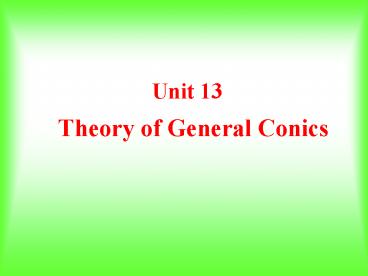Theory of General Conics - PowerPoint PPT Presentation
1 / 16
Title:
Theory of General Conics
Description:
is a parabola, an ellipse, a hyperbola, a circle, a point, or a pair of straight ... Since ellipse and hyperbola both have a centre, they are called central conics. ... – PowerPoint PPT presentation
Number of Views:155
Avg rating:3.0/5.0
Title: Theory of General Conics
1
Unit 13
- Theory of General Conics
2
13.1 Reduction of Equations of Quadratic Curves
to Standard Forms
3
13.1 Reduction of Equations of Quadratic Curves
to Standard Forms
4
13.1 Reduction of Equations of Quadratic Curves
to Standard Forms
5
13.1 Reduction of Equations of Quadratic Curves
to Standard Forms
6
13.1 Reduction of Equations of Quadratic Curves
to Standard Forms
Any equation of a quadratic curve can be reduced
to a standard equation of a conic by the
following steps of transformation of coordinate
axes
7
13.1 Reduction of Equations of Quadratic Curves
to Standard Forms
8
P.472 Ex. 13A
9
13.2 Invariants
The coefficients of the quadratic terms (i.e. x2,
y2 and xy terms) of the equation of a quadratic
curve Ax2 Bxy Cy2 Dx Ey F0 are
invariants under translation of coordinate axes.
10
13.2 Invariants
A C and B2 4AC of the equation of the
quadratic curve Ax2 Bxy Cy2 Dx Ey
F0 are invariants under rotation of coordinate
axes about the origin.
11
13.2 Invariants
A C and B2 4AC of the equation of the
quadratic curve Ax2 Bxy Cy2 Dx Ey
F0 are invariants under the transformation of
coordinate axes.
12
13.2 Invariants
The graph of the quadratic equation Ax2 Bxy
Cy2 Dx Ey F0 is a parabola, an ellipse, a
hyperbola, a circle, a point, or a pair of
straight lines.
Since ellipse and hyperbola both have a centre,
they are called central conics. On the contrary,
parabola, which has no centre, is known as
non-central conic.
13
13.2 Invariants
A circle, a single point and a pair of straight
lines are particular cases of conics. A single
point is known as degenerated ellipse. A pair of
intersecting straight lines is known as
degenerated hyperbola while a pair of parallel
straight lines or coincident straight lines is a
degenerated parabola.
14
13.2 Invariants
15
13.2 Invariants
- Remarks
- The sign of B2 - 4AC determines the type of curve
that an equation of second degree. This
expression is quite easy to be memorized since it
is analogous to the discriminant, b2 - 4ac, of a
quadratic equation ax2 bx c 0. - To determine the type of curve that an equation
of second degree represents, first we have to
check whether it represents a pair of straight
lines or not and then check the sign of B2 4AC
for conics.
16
P.478 Ex. 13B































